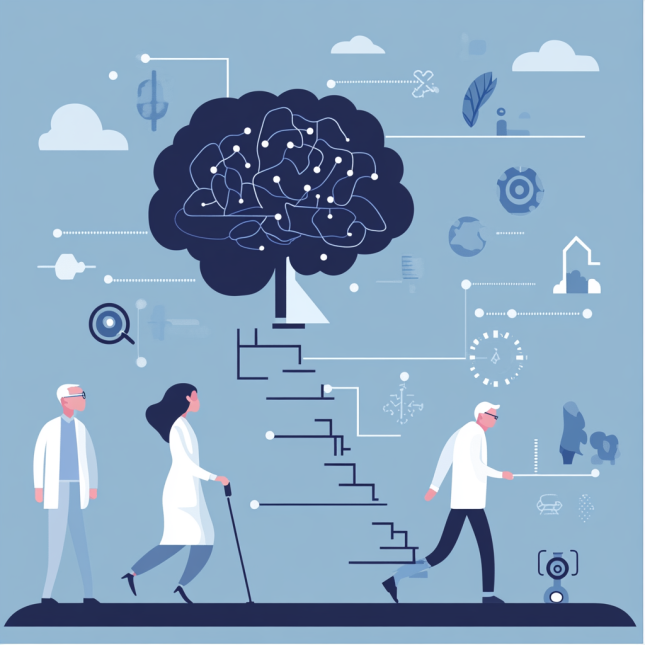summary
Lead Section
The initiative to leverage artificial intelligence (AI) for analyzing 1.6 million brain scans aims to develop predictive tools for assessing dementia risk, a significant advancement in the field of neurodegenerative disease research. Dementia, a complex syndrome characterized by cognitive decline and memory loss, affects millions globally and poses significant challenges in diagnosis and treatment due to its diverse underlying causes and symptomatology.[1][2] Traditional diagnostic methods often fall short in accuracy and timely detection, prompting the need for innovative approaches that can identify subtle changes in brain function long before clinical symptoms manifest.[3][4] This groundbreaking project represents a collaborative effort among leading academic institutions, including the University of Dundee and the University of Edinburgh, as well as private sector partners and research organizations.[5][6] Utilizing advanced machine learning techniques, the study aims to account for complex interactions among various risk factors for dementia, such as genetics and cardiovascular health, which traditional linear models may overlook.[1][7] The project aspires to not only enhance the accuracy of dementia risk predictions but also improve the efficiency of clinical workflows, potentially revolutionizing patient care in this domain.[7][8] Despite its promising potential, the integration of AI in dementia research is not without controversies and challenges. Concerns regarding data quality, generalizability of AI models across diverse populations, and the ethical implications of AI in healthcare raise critical questions about the reliability and applicability of these predictive tools.[9][10] Furthermore, achieving regulatory approval remains a significant hurdle, with only a few AI methods authorized for clinical use in neuroimaging related to dementia.[1][9] As researchers continue to refine their methodologies, addressing these challenges will be crucial for the successful implementation of AI-driven tools in clinical settings.[8][10]
Background
Dementia is a complex syndrome characterized by a sustained decline in brain function, which affects everyday activities and can present various symptoms, including memory loss, attention deficits, and difficulties in reasoning and communication[1]. The underlying causes of dementia are diverse, making its diagnosis challenging. Traditional diagnostic methods often rely on imaging techniques such as computed tomography angiography (CTA), magnetic resonance angiography (MRA), and digital subtraction angiography (DSA). Each of these methods has its advantages and limitations: while CTA offers high sensitivity and specificity, it is less effective in detecting small intracranial aneurysms due to the similar absorption effects of contrast agents and calcium[2]. MRA provides a non-invasive alternative with accurate measurements but suffers from longer imaging times and lower resolution, whereas DSA remains the gold standard due to its high spatial resolution, albeit with inherent risks due to its invasive nature[2]. Machine learning (ML) techniques have begun to play a significant role in dementia research, particularly in understanding the intricate relationships between modifiable and non-modifiable risk factors[1]. Studies suggest that many risk factors for dementia are correlated, yet interactions among these factors are often overlooked, leading to overly simplistic conclusions about their impact on dementia risk. Recent findings emphasize that lifestyle choices and interventions may significantly mitigate the risk, with some estimates suggesting that up to 40% of new dementia cases could be preventable by targeting twelve modifiable factors, including education, hypertension, and physical inactivity[1]. As the demand for accurate and timely diagnoses increases, AI-driven approaches are being developed to analyze large datasets, such as brain scans. A notable initiative aims to leverage AI to examine 1.6 million brain scans to create predictive tools for assessing dementia risk. This method not only seeks to enhance diagnostic accuracy but also aims to identify subtle changes in brain function years before the onset of clinical symptoms, thereby facilitating early intervention[3][4]. Such advancements underscore the potential for AI and machine learning to revolutionize dementia diagnosis and management by integrating diverse data sources and enabling a more nuanced understanding of this complex condition.
Methodology
Data Collection and Preparation
The methodology for this research involved meticulous curation of brain MRI images and associated tumor detection data. Three distinct datasets were selected for evaluation: BD-BrainTumor, Brain-Tumor-detection, and Brain-MRI-images-for-brain-tumor-detection. Each dataset underwent a series of preprocessing steps, including resizing, grayscale conversion, normalization, and data augmentation to enhance the generalization capabilities of the models being trained[11][12]. The aim was to ensure that the models could effectively handle diverse image qualities and variations that are typical in medical imaging.
Model Development
The research utilized a multi-stage methodology that integrated advanced image preprocessing techniques with the EfficientNetB2 architecture. This neural network architecture was chosen for its ability to elevate the accuracy of brain tumor detection significantly. The training of the models involved a process where algorithms were trained on annotated datasets to identify patterns associated with various types of brain tumors[11]. The performance metrics from the models were then evaluated based on their ability to classify unseen data accurately.
Dataset Segmentation
An exhaustive organizational strategy was implemented to create distinct subsets within the dataset. The primary segmentation involved dividing the datasets into three crucial subsets: training, validation, and testing. This partitioning was essential to assess the performance and generalizability of the trained models effectively[12].
Validation and Testing
The effectiveness of the proposed model was validated through comprehensive testing on the aforementioned datasets. This involved the use of confusion matrices to visually represent the classification results and to gauge the model’s performance in identifying brain tumors from the MRI scans[11]. Figures illustrating the classification reports were included to provide a clearer understanding of the models’ accuracy and reliability.
Ethical Considerations
Ethics and regulatory considerations were critical in the dataset selection process, as the research aimed to ensure that diverse populations were represented adequately. This is particularly important given that longitudinal datasets may lack generalizability due to potential exclusions based on socio-economic status, ethnicity, and other factors[10]. Ensuring diversity in the dataset helped mitigate bias and aimed to enhance the clinical applicability of the findings.
Future Implications
The methodology emphasizes the potential for future research to refine and enhance diagnostic precision in medical imaging. By addressing the challenges identified during the study, the research lays the groundwork for ongoing improvements in AI applications within healthcare, particularly in predicting dementia risk and other related conditions[13][9].
Objectives
The primary objective of utilizing artificial intelligence (AI) in the analysis of 1.6 million brain scans is to enhance the prediction of dementia risk. This involves developing advanced machine learning (ML) models that account for the complex interactions between various modifiable and non-modifiable risk factors, including age, genetics, and cardiovascular health[1]. By employing sophisticated techniques such as deep neural networks and extreme gradient boosting trees, researchers aim to move beyond linear modeling approaches that have historically dominated dementia risk prediction tools[1].
Development of Comprehensive Models
A key aim is to create comprehensive models that can better capture the non-linear effects and interactions among multiple risk factors, which traditional methods often overlook[1][7]. For instance, mid-life hypertension has been observed to increase dementia risk, yet it may appear protective during prodromal dementia stages[1]. Understanding these nuanced relationships is essential for effective intervention strategies.
Data Integration and Generalization
Another objective is to integrate diverse datasets, including demographics, medical histories, neuropsychological evaluations, and biomarker data obtained from less-invasive methods such as blood tests and brain imaging[13][12]. This holistic approach not only enhances the generalizability of the predictive models but also improves their accuracy in real-world clinical settings[14]. Collaborating with healthcare institutions is crucial for validating these models against real patient data to ensure their practical utility[7].
Addressing Limitations in Current Models
Future research aims to address the limitations present in existing dementia risk prediction tools. This includes refining automated data cleaning methods to facilitate broader access to electronic health record (EHR) data, thus enabling non-technical personnel to contribute to data analysis and model training[9]. Moreover, enhancing the interpretability of AI-driven tools through techniques like Gradient-weighted Class Activation Mapping (Grad-CAM) will help align model outputs with expert clinical judgments[7].
Collaborating Institutions
The initiative to utilize artificial intelligence (AI) for analyzing 1.6 million brain scans involves a diverse consortium of academic institutions, research organizations, and private sector partners. Key collaborators include the University of Dundee, where Professor Emanuele Trucco, an expert in AI and medical imaging, co-leads the SCAN-DAN project aimed at predicting dementia and neurodegenerative diseases[5][15]. The University of Edinburgh plays a significant role, with Professor Will Whiteley from the Centre for Clinical Brain Sciences co-leading the project. This institution is also part of the NEURii collaboration, which includes global pharmaceutical companies like Eisai and Gates Ventures, alongside the national health data science organization Health Data Research UK and the medical research charity LifeArc[6][15]. NEURii aims to facilitate the transition of digital health tools from research to market by removing barriers through funding and expertise[6]. Further support for the research comes from the Alzheimer’s Disease Neuroimaging Initiative (ADNI), which is coordinated by the Alzheimer’s Therapeutic Research Institute at the University of Southern California. This project involves various clinical sites across Canada, receiving funding from the Canadian Institutes of Health Research[16][12]. The project also benefits from partnerships with multiple private sector organizations, including NeuroRx Research, Novartis Pharmaceuticals, and Pfizer Inc., which provide additional resources and expertise[16][2].
Challenges and Limitations
The integration of Artificial Intelligence (AI) in analyzing brain scans for dementia risk presents various challenges and limitations that must be addressed for effective implementation.
Data Quality and Generalizability
One of the foremost issues is the quality of data, particularly with Electronic Health Records (EHR). Studies have highlighted several dimensions of data quality, including completeness, correctness, concordance, plausibility, and currency[9]. However, there is no consensus on how to evaluate data quality comprehensively. The presence of missing or inaccurate data can significantly impact the reliability of AI predictions[9]. Furthermore, the generalizability of AI models is contingent on the diversity of the training data. If the data lacks representation across different populations, the AI’s predictions may not be applicable universally, limiting its utility in clinical settings[10].
Ethical and Regulatory Considerations
The ethical landscape surrounding AI applications in healthcare remains complex. Recent guidance from the World Health Organization underscores the need for ethical principles to guide AI/ML developers[10]. Additionally, clear regulatory frameworks must delineate the responsibilities of AI developers and healthcare providers, particularly regarding accountability for errors generated by AI tools[10]. This is crucial for fostering trust among clinicians and patients alike.
Computational Demands
AI models, particularly complex architectures, often require significant computational resources, which can pose practical limitations in clinical environments[2]. High computational demands may lead to latency in system response times, rendering AI tools less effective in real-time applications such as surgical treatments. Optimizing AI systems to reduce latency is therefore essential for meeting clinical needs[2].
Feature Engineering and Interpretability
Despite the promise of AI, challenges persist in feature engineering and model interpretability. Effective AI applications often depend on prior knowledge to define valuable features[13]. However, without expert involvement, important clinical insights may be overlooked. Additionally, AI models must be interpretable to clinicians, as understanding how decisions are made is vital for integrating AI recommendations into clinical practice[13].
Future Directions
To enhance the reliability of AI models for dementia risk prediction, future research must focus on improving data quality, addressing ethical and regulatory challenges, and developing frameworks for model interpretability. These advancements are crucial for ensuring that AI can be effectively utilized in routine clinical settings[8][2].
Expected Outcomes
The ambitious project to utilize artificial intelligence (AI) for analyzing 1.6 million brain scans aims to establish a robust predictive tool for dementia risk. Initial findings suggest that advanced machine learning (ML) models can effectively identify patterns associated with Alzheimer’s disease (AD) progression through neuroimaging data, enhancing prediction capabilities compared to traditional methods[8]. The application of these models, including those validated by LASSO regression, holds promise for accurately estimating individual risk factors for developing prodromal AD or dementia[16][10]. The AI system’s development is anticipated to culminate in a user-friendly interface that integrates seamlessly into existing clinical workflows, thereby aiding radiologists in making more informed decisions[7]. This will not only improve diagnostic accuracy but may also enhance the efficiency of the evaluation process in clinical settings[7]. As researchers engage in collaborative efforts to refine the predictive algorithms, they expect to generate insights that will lead to new treatment methodologies and preventive strategies[17][18]. Furthermore, systematic reviews indicate that the combination of neuroimaging data with sophisticated learning algorithms is likely to facilitate a deeper understanding of AD’s progression, allowing for personalized healthcare approaches tailored to individual risk profiles[8]. Through the extensive data collection from high-risk populations, the project aspires to drive significant advancements in both the understanding and management of dementia, ultimately improving patient outcomes[18][8].
Related Research
AI and Neuroimaging in Dementia
Recent advancements in artificial intelligence (AI) and machine learning have sparked a surge of interest in analyzing complex datasets to address the challenges posed by dementia. By the end of 2022, there were 2,385 publications focusing on AI applications in dementia research, primarily emphasizing predictive and diagnostic capabilities rather than direct patient care[1]. Neuroimaging, which generates vast and intricate data, has proven particularly amenable to AI techniques, facilitating the exploration of disease mechanisms and enhancing clinical diagnosis[1].
Generative Models in Neuroimaging
Innovative generative models, such as MouseGAN and SC-GAN, have been developed to improve neuroimaging analysis tasks. MouseGAN focuses on segmenting mouse brain structures in MRI images, while SC-GAN synthesizes multimodal 3D neuroimaging data. These models demonstrate the potential to refine existing analysis methods and create novel tools for diagnosis and patient follow-up[13]. The integration of these advanced models could further enrich the insights gained from neuroimaging data.
Regulatory Challenges
Despite the promise of AI in dementia research, there are substantial hurdles to clinical application, particularly concerning regulatory approval. Only four AI methods have been authorized for clinical use in neuroimaging for dementia within the US or EU, all of which are primarily focused on image segmentation rather than direct classification of patient groups[1]. This reflects a significant challenge in translating research innovations into practical tools for healthcare providers.
Multidisciplinary Initiatives
Collaborative efforts, such as the Alzheimer’s Disease Neuroimaging Initiative and Dementias Platform UK, highlight the importance of leveraging extensive, multidisciplinary datasets to propel research forward. Competitions like the TADPOLE Challenge and workshops by the EuroPOND consortium aim to develop novel statistical methodologies to further enhance the application of AI in dementia research[1].
Broader Applications of AI in Medical Imaging
AI’s integration into medical imaging extends beyond dementia to enhance the identification of brain tumors through MRI scans. Utilizing architectures like EfficientNetB2, researchers have developed methodologies that combine advanced image preprocessing techniques to significantly improve diagnostic accuracy[11]. This underscores AI’s transformative potential in clinical workflows, where improved precision in diagnostic processes can directly benefit patient care.
Future Directions
As research in AI and neuroimaging continues to evolve, there is a growing emphasis on combining multiple imaging modalities—such as PET, MRI, and EEG—to achieve a more comprehensive understanding of neurological conditions[8]. The continued exploration of innovative methodologies and collaborative research will be essential in bridging the gap between advanced AI technologies and their practical applications in clinical settings.
Show as PDF
References
[1]: Harnessing the potential of machine learning and artificial …
[2]: Classification, detection, and segmentation performance of image-based …
[3]: AI brain scans detect early Alzheimer’s with 90% success
[4]: AI Outperforms: Stunning 82% Accuracy in Predicting … | SciTechDaily
[5]: Advanced AI-driven approach for enhanced brain tumor detection from MRI …
[6]: Machine learning methods for predicting progression from mild cognitive …
[7]: Understanding machine learning applications in dementia research and …
[8]: Frontiers | Generative AI for brain image computing and brain network …
[9]: An automated data cleaning method for Electronic Health Records by …
[10]: Enhancing brain tumor detection in MRI images through explainable AI …
[11]: An Explainable AI Paradigm for Alzheimer’s Diagnosis Using Deep …
[12]: AI software tool aims to spot early signs of dementia from brain scans
[13]: New AI tool could predict person’s risk of dementia after university …
[14]: AI software tool aims to spot early signs of dementia from brain scans …
[15]: Multipredictor risk models for predicting individual risk of Alzheimer …
[16]: Neuroimaging and machine learning for studying the pathways from mild …
[17]: One million brain scans used to assess dementia risk – BBC
[18]: One million brain scans used to assess dementia risk – BBC











